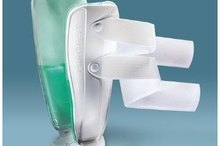What does fact checked mean?
At Healthfully, we strive to deliver objective content that is accurate and up-to-date. Our team periodically reviews articles in order to ensure content quality. The sources cited below consist of evidence from peer-reviewed journals, prominent medical organizations, academic associations, and government data.
The information contained on this site is for informational purposes only, and should not be used as a substitute for the advice of a professional health care provider. Please check with the appropriate physician regarding health questions and concerns. Although we strive to deliver accurate and up-to-date information, no guarantee to that effect is made.
How to Bathe With an Arm Sling
A broken bone, sprain, dislocated shoulder or other arm injury requiring a sling creates a difficult, but not impossible, bathing experience. Still, skipping a dip into your bathtub isn’t an option for most. When you have to wear a sling it will take a bit more time, patience and creativity in order to stay clean. Casts often accompany slings when an arm fracture is present, and will require additional precautions.
Remove the sling when getting undressed and preparing for a bath. However, do not remove the sling if your doctor has stated you must wear it at all times.
How to Care for a Dislocated Shoulder
Learn More
Place a plastic arm sleeve cover over your sling. A bathing sleeve holds the injured arm in a large piece of plastic that looks similar to a large fabric sling. Slip your sling and your arm into the cover, to protect your shoulder and arm from the water. Commercially sold sling covers for showering and bathing can also be purchased through most medical supply stores and pharmacies.
Place all necessary items you will need for your bath on one side of the bathtub, near the uninjured arm. Ensure items are easy to reach so you will avoid added strain to the injured arm.
How to Prevent Infection in Pierced Ears
Learn More
Keep your injured arm close to your side. Do not move the arm and keep it as stable as possible to prevent further injury. Only use the unaffected arm to lather and wash your body, advises ShoulderSurgeon.com 2.
Do not rush taking a bath. Bathing with an injured arm will take longer. Schedule plenty of time to get undressed and bathe. If you are in a rush, use the non-injured arm to give yourself a quick sponge bath. Ask a family member or close friend for assistance.
Replace the sling if it gets wet with a clean, dry sling. Blow dry the wet sling with a hair dryer or place it in the dryer for a few moments after bathing if a second sling is not available.
Tips
Check the skin around the cast for irritation, redness or odor on a regular basis. Do not remove the sling if a medical professional has stated to wear the sling or other immobilizer device at all times.
Related Articles
References
- FamilyDoctor.org: Cast Care
- ShoulderSurgeon.com: Tips for Self Care
- ShoulderDoc: Living with a Shoulder Sling
- Cleveland Clinic. Shoulder Fractures.
- Hollman F, Wolterbeek N, Zijl JAC, Van egeraat SPM, Wessel RN. Abduction Brace Versus Antirotation Sling After Arthroscopic Cuff Repair: The Effects on Pain and Function. Arthroscopy. 2017;33(9):1618-1626. doi:10.1016/j.arthro.2017.02.010
- Johns Hopkins Medicine. Arm Care After a Stroke.
Writer Bio
Julie Hampton has worked as a professional freelance writer since 1999 for various newspapers and websites including "The Florida Sun" and "Pensacola News Journal." She served in the U.S. Army as a combat medic and nurse for over six years and recently worked as the Community Relations Director for a health center. Hampton studied journalism and communications at the University of West Florida.








